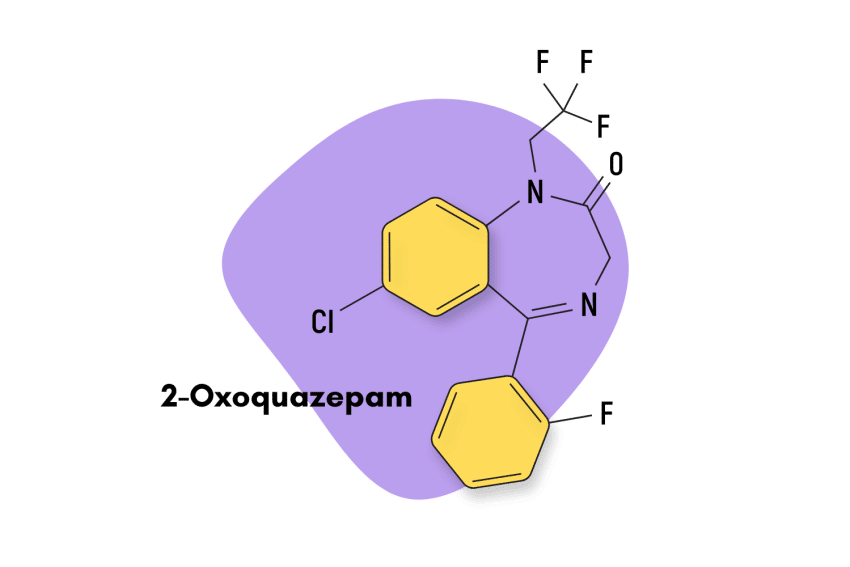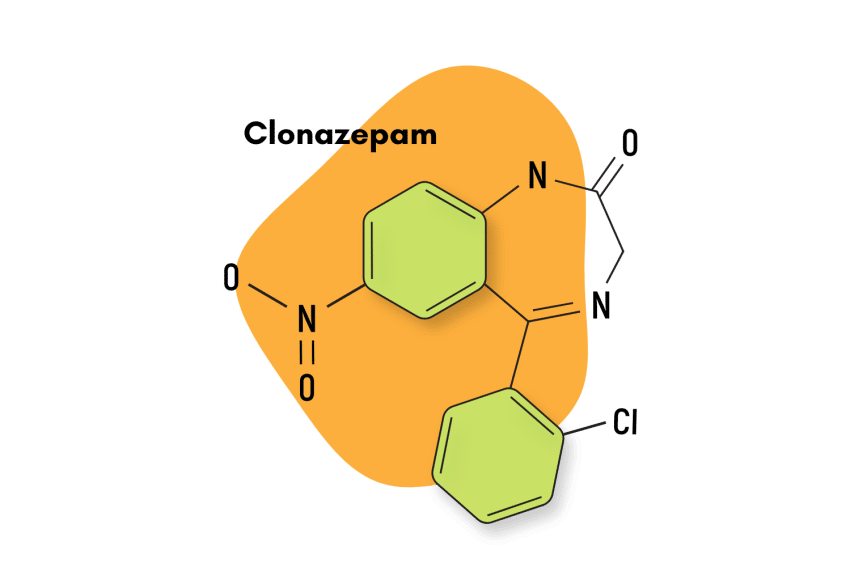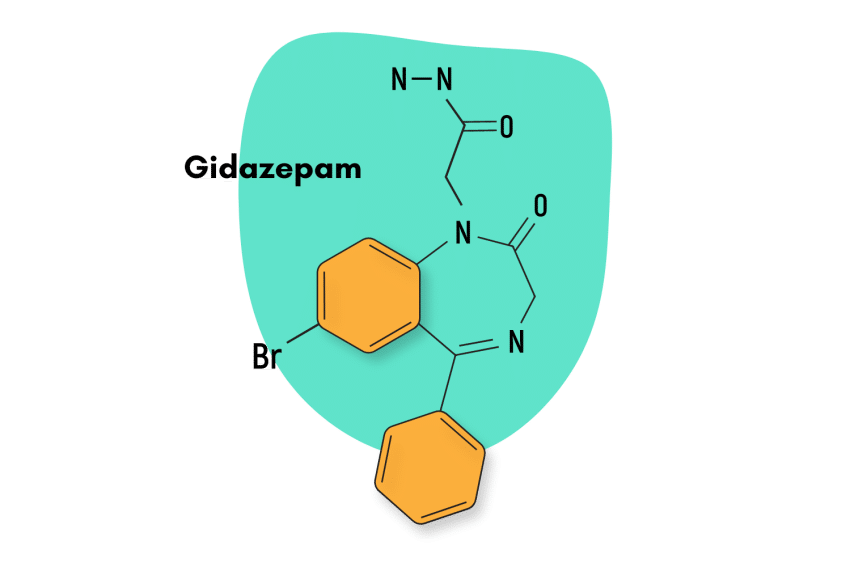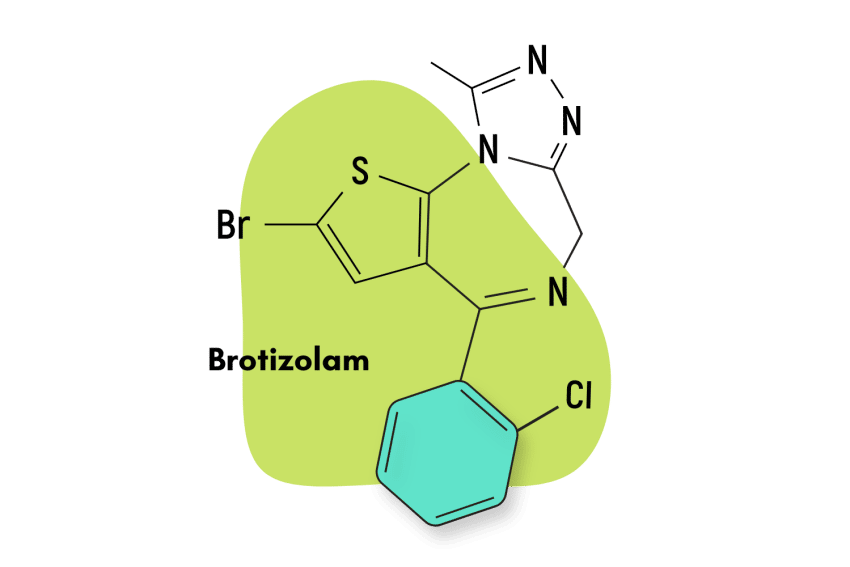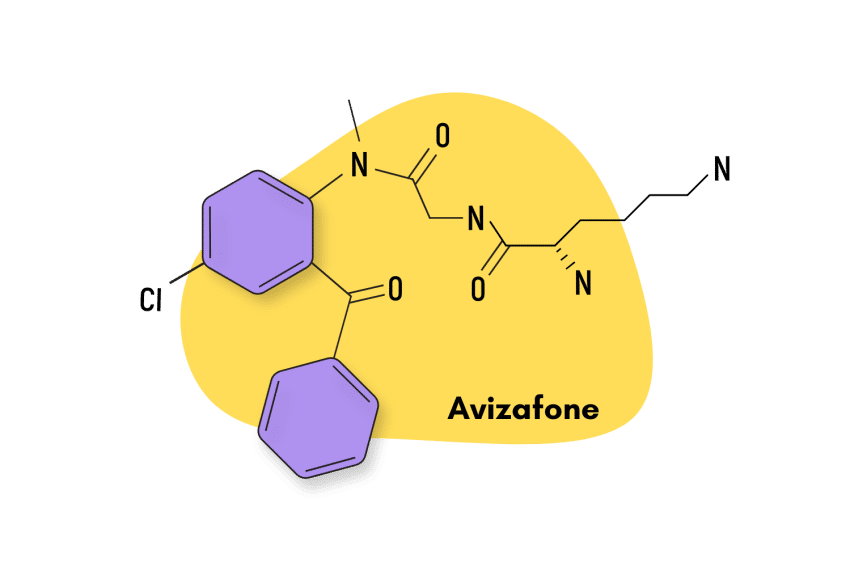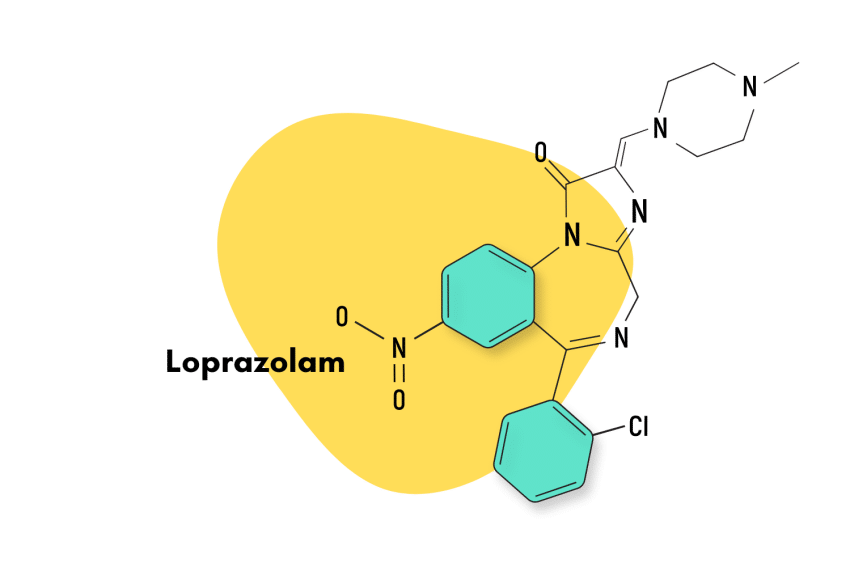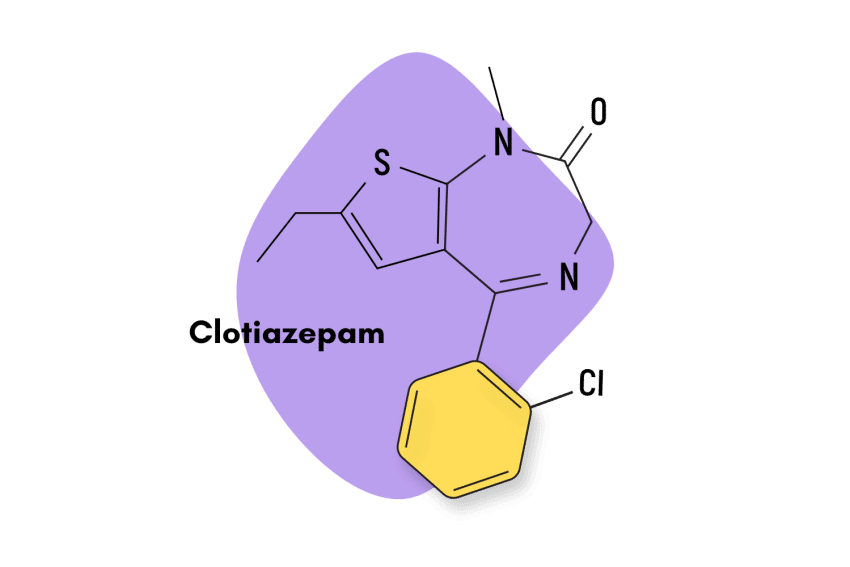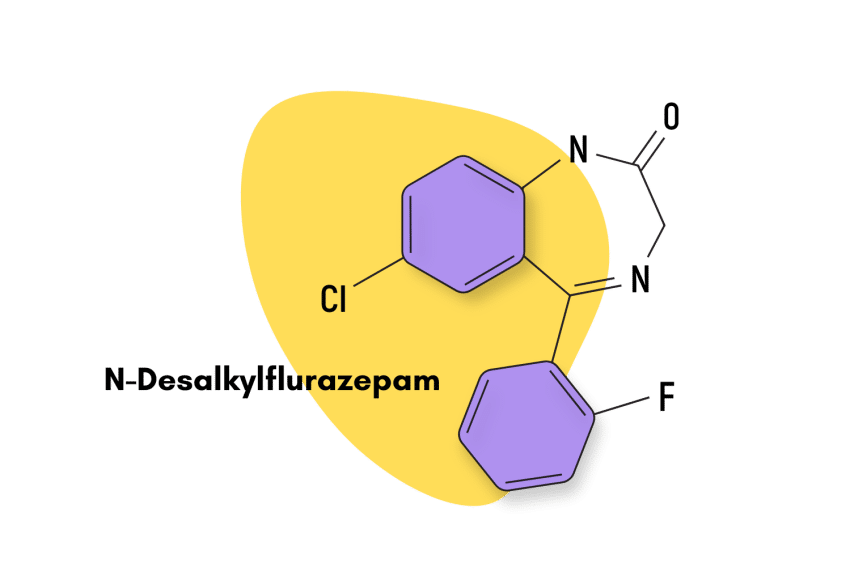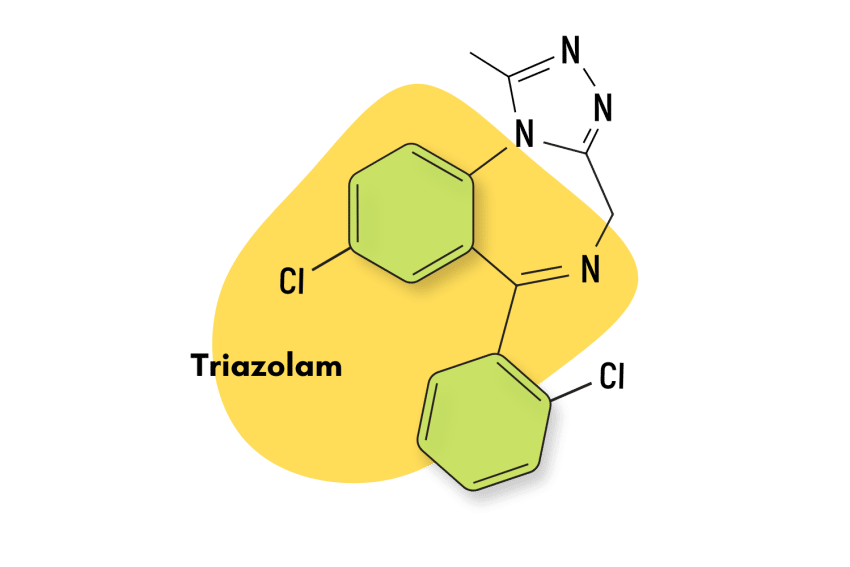Pinazepam (Domar): Is This The Closest Alternative to Valium?
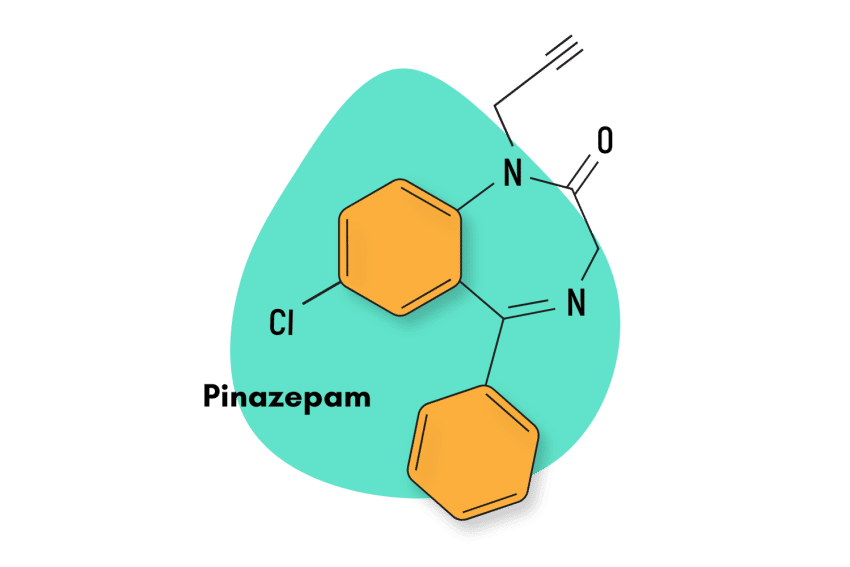
Pinazepam, sold under the brand name Domar and Duna, is a benzodiazepine derivative first released in 1988 in Germany.
Studies show that pinazepam is a prodrug for N-desmethyldiazepam (AKA nordiazepam), which is responsible for the majority of its effects [1]. In terms of effects, pinazepam is most often compared to diazepam (Valium).
Pinazepam demonstrates less toxicity, sedation, and muscle-relaxant activity than diazepam and remains active for several hours longer [2].
Because it has minimal hypnotic effects, pinazepam is mainly used as an anxiolytic agent during the day [3].
Pinazepam Specs:
| Status: | Approved 💊 |
| Common Dosage: | 10 mg |
| PubChem ID: | 40391 |
| CAS# | 52463-83-9 |
IUPAC Name: 7-chloro-5-phenyl-1-prop-2-ynyl-3H-1,4-benzodiazepin-2-one
Other Names: Domar, Duna, Pinazepam [INN], ZAMI 905, UNII-5286RBZ882, Pinazepamum
Metabolism:
Pinazepam is mostly metabolized into inactive metabolites by the cytochrome P450 enzymes, including the CYP3A4 enzyme in the liver. It has been shown to cross the placenta, and its active compound has been found in breast milk as well [1]. The main metabolite found in the urine of rats treated with pinazepam was oxazepam [2].
Duration of Effects:
Pinazepam is a long-acting drug. The half-life of pinazepam is more than 48 hours [4]. The total effects of this drug last between 18 and 36 hours.
What is the Dose of Pinazepam?
The usual dose of pinazepam is a single oral dose of 10 mg in two divided doses. It’s considered to be of roughly comparable potency as diazepam (Valium).
Pinazepam Dosage Equivalents
**Caution:** Benzodiazepines have a narrow therapeutic window. Dose equivalents may not be accurate in higher doses.
This calculator does not substitute for clinical experience and is meant to serve only as a reference for determining oral benzodiazepine equivalence.
Please consult a medical practitioner before taking benzodiazepines.
How Does Pinazepam Work?
Benzodiazepines like pinazepam bind to GABA-A receptors and enhance the natural inhibitory effect of GABA [5]. This naturally-occurring neurotransmitter acts as the body’s primary inhibitory messenger. When we feel anxious, GABA is responsible for inhibiting electrical activity to slow our thoughts and calm us down.
Benzodiazepines like pinazepam work by actively promoting this inhibition by ameliorating GABA — resulting in a reduction in anxiety, aggression, stimulation, and overall cognition [3,6,7,8].
As a side effect of this cognitive inhibition, benzos like pinazepam also make it harder to form new memories (while the drug remains active), stay focused, or think abstractly.
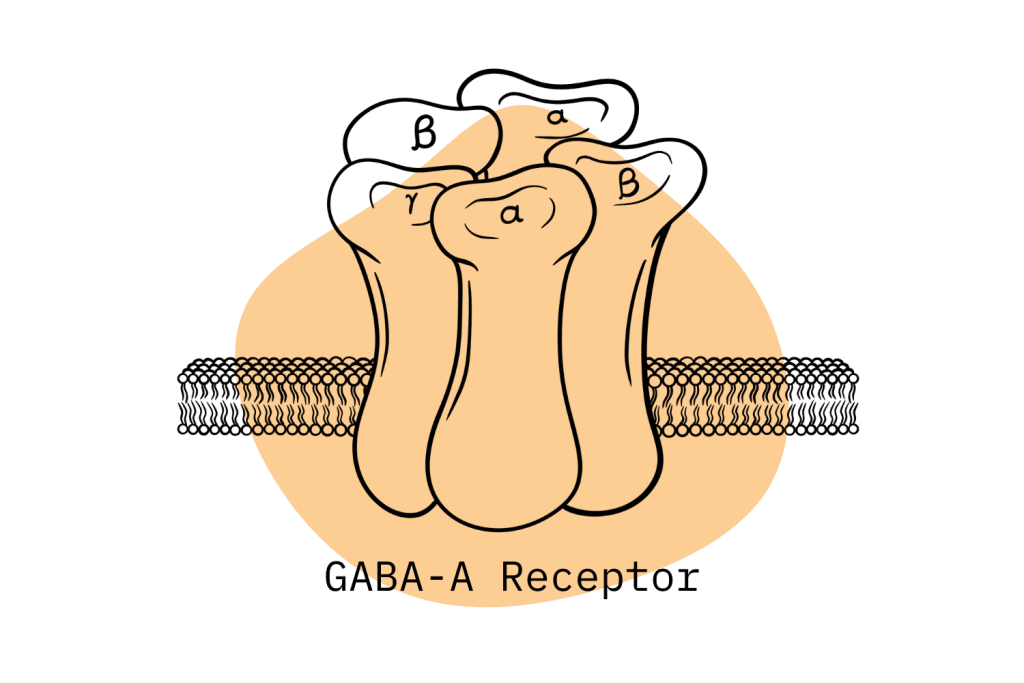
Is Pinazepam Safe? Risks & Side-Effects
Pinazepam should only be used under the prescription of a doctor. Although pinazepam is reported to carry a lower risk for dependency, it should not be taken lightly.
Abdominal cramps, anxiety, sweating, trembling, blurred vision, concentration issues, and dizziness are just a few of the unpleasant withdrawal symptoms that can develop in people who are dependent on the drug and stop using it abruptly.
This drug becomes significantly more dangerous if combined with other neuroinhibitory substances — including alcohol, GHB, opiates, barbiturates, phenibut, other benzodiazepines, and a variety of other substances. These drug interactions can be fatal.
When taken as directed by your doctor and with full disclosure of your medical history and current medication regimen, pinazepam is considered a safe medication.
Even if you carefully follow the directions, you can still have some adverse effects. Mild to severe adverse effects are possible.
Side Effects Of Pinazepam
Common side effects of pinazepam may include:
- Drowsiness
- Lightheadedness
- Weakness
- Instability
- Temporary sleepiness
- Headache
- Sleep difficulty
- Confusion
- Irritability
- Aggressiveness
- Excitation
Rare, but serious side effects of pinazepam may include:
- Disorientation
- Slurred speech
- Convulsions
- Memory impairment.
- Seizures
- Extreme sleepiness
- Coma
- Trembling
- Sluggish pulse
- Breathing difficulties
- Extreme weakness
Pinazepam Contraindications
There are some situations in which benzodiazepines are not considered safe. These situations are referred to as contraindications. Your doctor will be able to assess whether or not you can make an exception if you have one of the conditions below — otherwise, it’s best to avoid pinazepam and other benzodiazepine derivatives at all costs.
Contraindications for pinazepam may include:
- Glaucoma
- Any liver problems
- Any kidney problems
- Any lung conditions like chronic lung disease
- Pregnancy or breastfeeding women
- Any major operations
- Any psychiatric condition
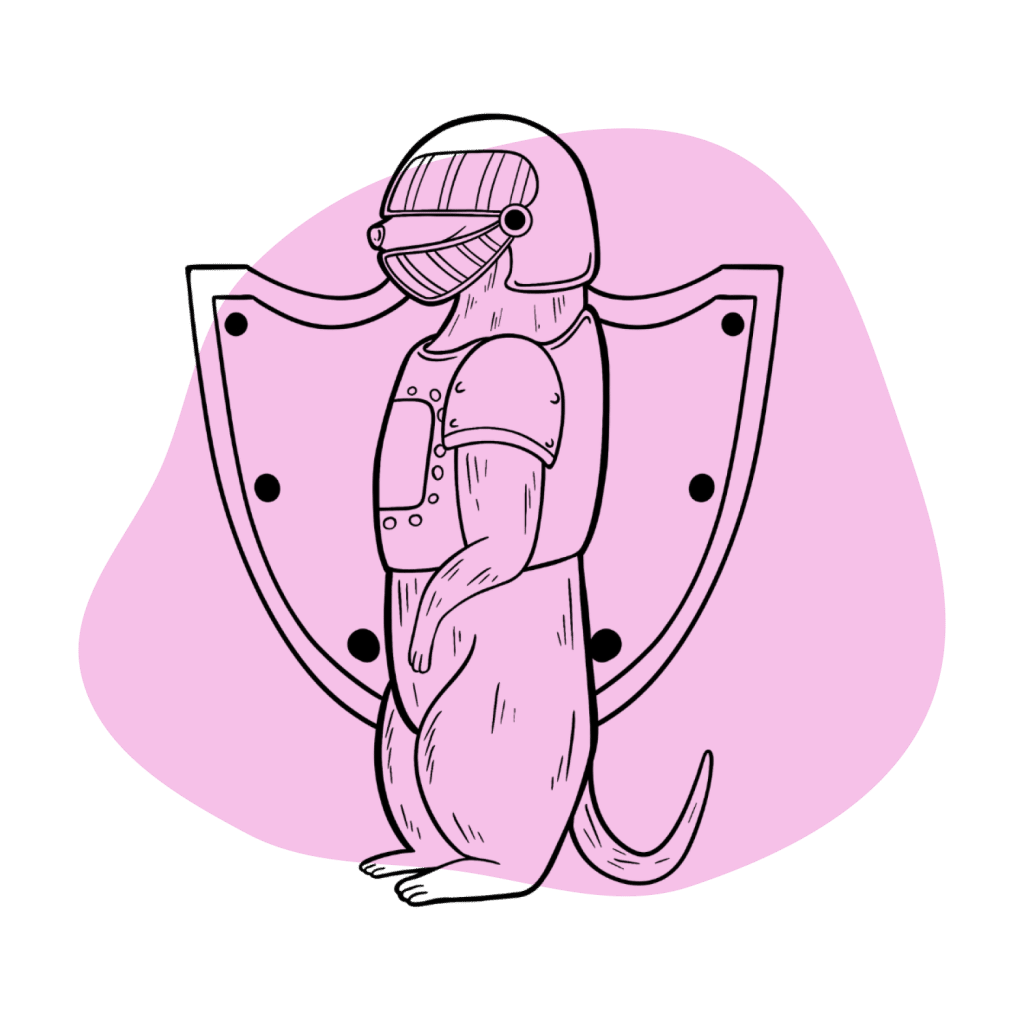
Harm Reduction: Pinazepam
Despite some medical professionals suggesting pinazepam is in some way “safer” than other benzodiazepines, this drug still comes with substantial risk.
There are four primary risks to using pinazepam:
- Adulteration of grey market pinazepam products
- Moderate risk of drug dependence and abuse
- Negative drug interactions, especially with other CNS depressants, can be lethal
- Pinazepam can alter cognitive function and may increase the risk of accidental injury
Therefore, harm reduction mainly involves the amelioration of these risk factors. Don’t mix with other drugs (unless otherwise instructed by your doctor), don’t use pinazepam in doses outside the recommended range or for more than four weeks at a time, don’t drive while under the effects of pinazepam, and always test a sample with a benzo test kit if purchasing from no regulated sources.
1. Do Not Mix Pinazepam With Other Substances
It is never a good idea to mix this drug with other drugs, especially drugs like benzodiazepines, sedatives, hypnotics, and certain SSRIs like fluvoxamine, antihistamines, and some antibiotics and antifungals. Inform your doctor of all the medications that you are currently taking in order to avoid any mishaps due to mixing.
2. Reducing The Risk Of Drug Dependence
Pinazepam has been shown to display low drug dependence, but care must be taken nonetheless to be careful in its use. You should not take this medication on your own or stop it without advice from your doctor. Once started, your doctor may prescribe this medicine for a few weeks, depending on your need.
3. Don’t Drive After Taking Pinazepam
It is advised that you avoid operating any heavy machinery or driving while taking this drug. Drugs like pinazepam may sometimes affect your coordination, so take care to limit these activities as much as you can or consider getting aid from someone, if you must, during the time you are on this drug.
4. Always Test a Sample of Your Drugs
Pinazepam is hard to find through regulated sources — most people who take this medication today sourced it from an unregulated online marketplace. The problem with these sources is that the vendors are already operating in a legal grey area, if not blatantly illegally already. These vendors often lack the integrity to ensure the products they’re selling are pure and safe.
For this reason, the same route is to assume all samples you order have been compromised and test them using a benzodiazepine test kit to ensure the contents are what they should be.
It’s not uncommon for benzodiazepine samples ordered online to include entirely different substances (such as other benzodiazepines, barbiturates, or opiates).
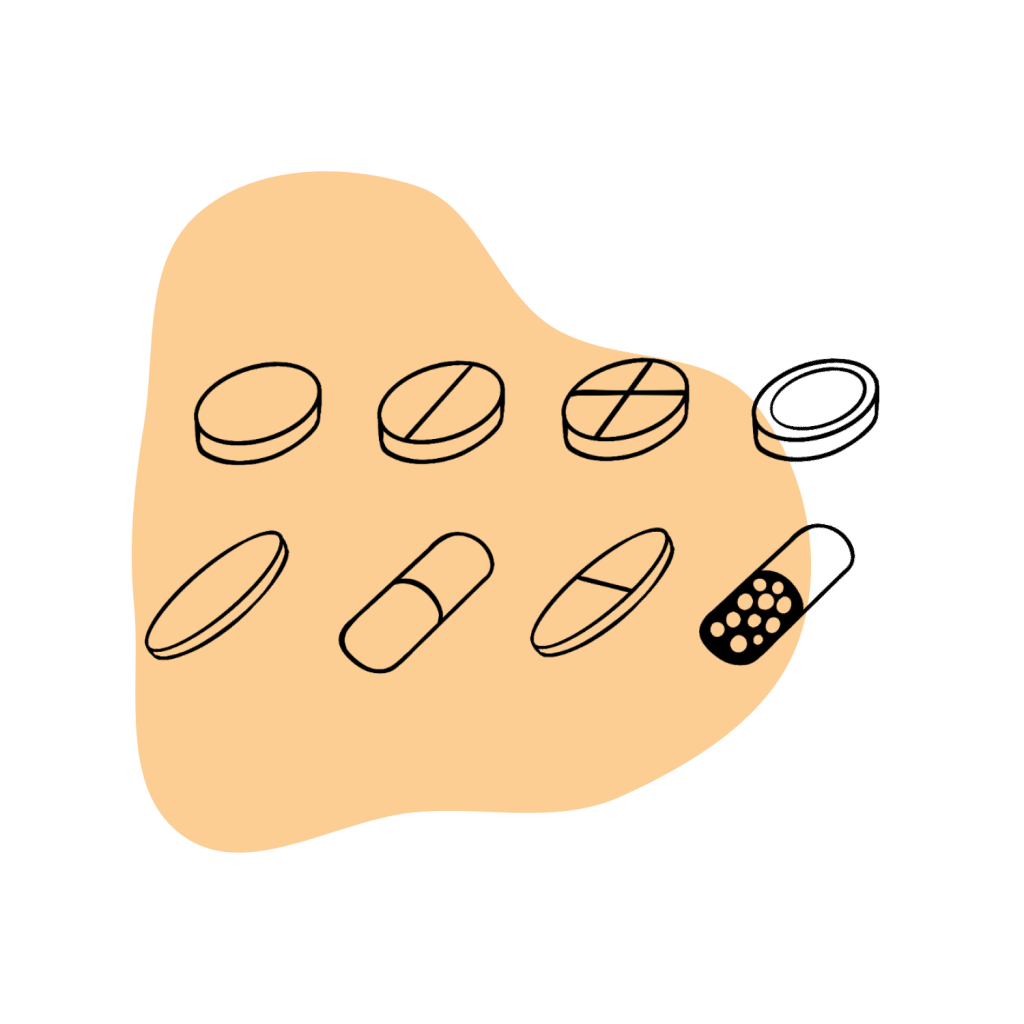
Similar Benzodiazepines
Pinazepam is a long-acting 1,4-benzodiazepine with a half-life of over 48 hours. The first effects of the drug start to kick in around 20–40 minutes after taking it.
Other benzodiazepines that share these qualities include chlordiazepoxide (Librium), clorazepate (Tranxene), diazepam (Valium), flubromazepam, flurazepam (Dalmadorm), flutoprazepam (Restas), halazepam (Paxipam), ketazolam (Anseren), medazepam (Azepamid), nitrazepam (Mogadon), nordiazepam (Madar), phenazepam (Phenazepam), and quazepam (Doral).
In terms of effects, pinazepam is most similar to diazepam, nordiazepam, medazepam (Nobrium), prazepam, and oxazolam.
Other popular benzodiazepines with similar effects include alprazolam (Xanax), bromazepam (Lectopam), lorazepam (Ativan), clonazolam (Klonopin), and triazolam (Halcion).
Pinazepam vs. Other Short To Intermediate-Acting Benzodiazepines:
| Pinazepam | Alprazolam | Bromazepam | Diazepam | Chlordiazepoxide | |
| Chemical composition: | 1,4-benzodiazepine | Triazolobenzodiazepine | 1,4-benzodiazepine | 1,4-benzodiazepine | 1,4-benzodiazepine |
| Route of administration: | Oral | Oral | Oral | IV, IM | Oral, IV |
| Onset of action: | 45 to 60 minutes | 20 to 60 minutes | 60 minutes | 15 to 60 minutes | 1 to 2 hours (oral) |
| Peak concentration: | 2 to 3 hours | 1 to 2 hours | 1 to 4 hours | 1 to 1.5 hours | 2 hours |
| Duration of effects: | Long-acting ( > 48 hours) | Short-acting (6 to 27 hours) | Intermediate-acting (8 to 19 hours) | Long-acting (20 to 80 hours) | Long-acting (36 to 200 hours) |
| Mechanism of action: | GABA-A receptor agonist | GABA-A receptor agonist | GABA-A receptor agonist | GABA-A receptor agonist | GABA-A receptor agonist |
| Medical Uses: | Anxiety disorder, insomnia, muscle relaxant | Panic disorders, anxiety disorders, insomnia | Anxiety disorder, alcohol withdrawal | Seizures, alcohol withdrawal, insomnia, muscle spasms, panic disorder, anxiety disorders | Panic disorders, alcohol withdrawal, anxiety disorders |
Natural Alternatives To Benzodiazepines
There are a few natural remedies that have effects comparable to those of pinazepam by boosting GABA activity.
Evaluating these medications for therapeutic use requires more research. Therefore, you should always check with your doctor before utilizing any natural Pinazepam alternatives.
Pinazepam’s natural substitutes include:
1. Kava
Kava (Piper Methysticum) belongs to the pepper family and is found predominantly in the pacific islands. Traditionally, it was used for relaxation, sleep support, and as a social lubricant similar to alcohol. Its mechanism of action involves a similar modulation of the GABA receptors as benzodiazepines — albeit to a much lesser extent.
Several studies have shown significant anxiolytic activity with kava [9].
2. Valerian root
Valerian, or Valeriana officinalis, is a flowering plant, and its roots are used traditionally to alleviate anxiety symptoms. It acts by reducing the degradation of GABA and may enhance the production of GABA as well. The end result is very similar to the anxiolytic and sedative effects of benzodiazepines.
Several studies have shown significant improvements in anxiety scores in humans compared with a placebo control [10].
3. St. John’s Wort
St. John’s Wort, or Hypericum perforatum, is a flowering plant with wide usage in Europe as an antidepressant. This herb works differently from benzodiazepines by preventing the reuptake of serotonin. This is the same mechanism of action used by prescription antidepressants in the SSRI category, such as citalopram (Cipramil), fluoxetine (Prozac), or sertraline (Lustral).
This herb is considered a good alternative to benzodiazepines in patients with both anxiety and depression.
4. Passionflower
Passionflower, or Passiflora incarnata, is a vine found growing in Central and South America. It acts as a monoamine oxidase inhibitor (MAOI). This effect exhibits a gentle but long-lasting antidepressant and anxiolytic action.
A randomized control trial has shown that passion flower is as effective as the benzodiazepine oxazepam in controlling anxiety with the added benefit of producing fewer side effects [10].
5. Ashwagandha
Used for thousands of years in Indian medicine, ashwagandha or winter cherry (Withania somnifera) is an evergreen shrub. It’s considered an adrenal tonic, helping to ease the long-term side effects of chronic stress and anxiety.
This herb is much gentler than other options on this list and has very few side effects associated with its use. It can take a while for ashwagandha to take effect, but unlike benzodiazepines, the changes it produces are long-lasting — addressing the root of the problem rather than offering a bandaid solution.
A recent double-blind, placebo-controlled trial demonstrated statistically significant reductions in anxiety levels after six weeks of use [11].
6. Chamomile
Chamomile (Matricaria chamomilla) is a member of the daisy family, often found growing like a weed in fields, abandoned lots, and roadsides. It’s known for its ability to soothe anxiety and promote more restful sleep.
Like benzos, chamomile works largely through amelioration of the GABA-A receptors but also interacts with dopamine, serotonin, and cortisol.
In an older 8-week study, chamomile extract showed significant reductions in generalized anxiety symptoms [12].
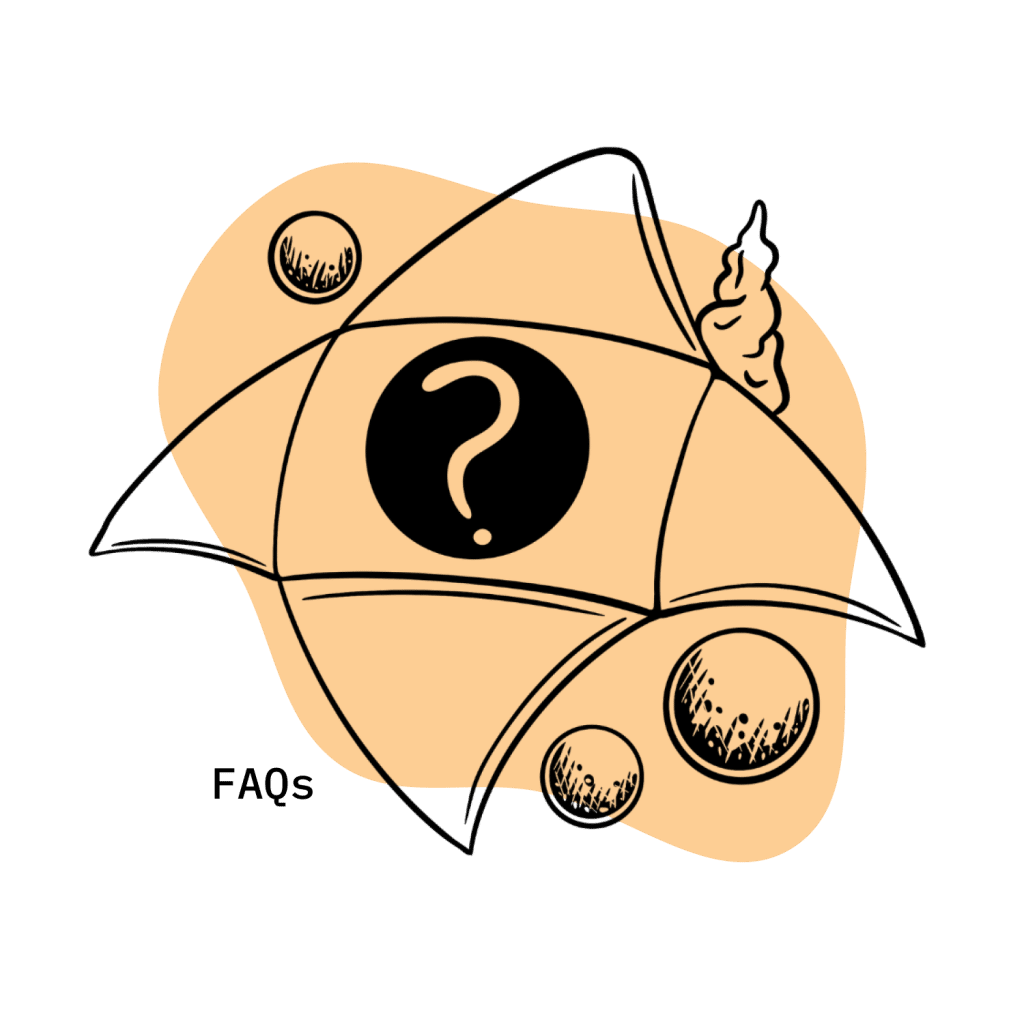
Pinazepam FAQs
How will pinazepam make me feel?
Pinazepam is a good drug for the alleviation of anxiety symptoms with minimal unwanted symptoms. But sometimes, it can cause sleepiness or drowsiness. Mostly, it should rid you of the anxiety symptoms without interfering with day-to-day activities.
How long does pinazepam take to work?
The onset of action will depend on what you take it for. For anxiety symptoms, it should take a few weeks to start showing benefits.
Will I become addicted after taking pinazepam?
Usually, the doctor will review the duration you will need to be on medication. Drugs like pinazepam do not cause serious addiction if used for a short period, like 2 to 4 weeks.
However, if you have any history of issues with addiction, it is best to discuss this with your doctor, as people with addiction problems might need more close supervision.
Do I need to avoid any foods or drinks while taking pinazepam?
Anything containing caffeine, like chocolates, tea, and coffee, can block pinazepam’s effects and lessen its intended action.
Similar to alcohol, pinazepam might intensify its sedative effects, causing you to fall asleep deeply and perhaps have trouble waking up.
References:
- Pacifici, G. M., Placidi, G. F., Fornaro, P., & Gomeni, R. (1982). Pinazepam: a precursor of N-desmethyldiazepam. European Journal of Clinical Pharmacology, 22(3), 225-228.
- Scrollini, F., Caliari, S., Romano, A., & Torchio, P. (1975). Toxicological and pharmacological investigations of pinazepam (7-chloro-1-propargyl-5-phenyl-3H-1, 4-benzodiazepine-2-one): a new psychotherapeutic agent. Arzneimittel-forschung, 25(6), 934-940.
- Janbroers, J. M. (1984). Pinazepam: a review of pharmacological properties and therapeutic efficacy. Clinical Therapeutics, 6(4), 434-450.
- Orsolini, L., Corkery, J. M., Chiappini, S., Guirguis, A., Vento, A., De Berardis, D., … & Schifano, F. (2020). ‘New/Designer Benzodiazepines’: an analysis of the literature and psychonauts’ trip reports. Current neuropharmacology, 18(9), 809-837.
- Jenner, P., Pratt, J. A., & Marsden, C. D. (1986). Mechanism of action of clonazepam in myoclonus in relation to effects on GABA and 5-HT. Advances in neurology, 43, 629-643.
- DeVane, C. L., Ware, M. R., & Lydiard, R. B. (1991). Pharmacokinetics, pharmacodynamics, and treatment issues of benzodiazepines: alprazolam, adinazolam, and clonazepam. Psychopharmacology bulletin, 27(4), 463-473.
- El Balkhi, S., Monchaud, C., Herault, F., Géniaux, H., & Saint-Marcoux, F. (2020). Designer benzodiazepines’ pharmacological effects and potencies: How to find the information. Journal of Psychopharmacology, 34(9), 1021-1029.
- Griffin, C. E., Kaye, A. M., Bueno, F. R., & Kaye, A. D. (2013). Benzodiazepine pharmacology and central nervous system–mediated effects. Ochsner Journal, 13(2), 214-223.
- Sarris, J., & Kavanagh, D. J. (2009). Kava and St. John’s Wort: current evidence for use in mood and anxiety disorders. The Journal of Alternative and Complementary Medicine, 15(8), 827-836.
- De Sousa, A. (2013). Herbal medicines and anxiety disorders: An overview. Journal of Medicinal Plants, 1(6).
- Andrade, C. (2009). Ashwagandha for anxiety disorders. The World Journal of Biological Psychiatry, 10(4-2), 686-687.
- Keefe, J. R., Mao, J. J., Soeller, I., Li, Q. S., & Amsterdam, J. D. (2016). Short-term open-label chamomile (Matricaria chamomilla L.) therapy of moderate to severe generalized anxiety disorder. Phytomedicine, 23(14), 1699-1705.

